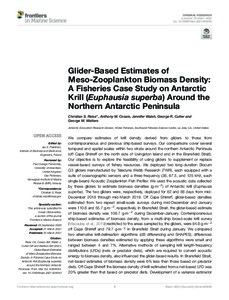| dc.contributor.author | Reiss, Christian S. | |
| dc.contributor.author | Cossio, Anthony M. | |
| dc.contributor.author | Walsh, Jennifer | |
| dc.contributor.author | Cutter, George R. | |
| dc.contributor.author | Watters, George M. | |
| dc.coverage.spatial | Antarctic Peninsula | |
| dc.coverage.spatial | Bransfield Strait | |
| dc.coverage.spatial | Cape Shirreff | |
| dc.date.accessioned | 2021-05-04T17:53:56Z | |
| dc.date.available | 2021-05-04T17:53:56Z | |
| dc.date.issued | 2021 | |
| dc.identifier.citation | Reiss, C.S., Cossio, A.M., Walsh, J.,
Cutter, G.R. and Watters, G.M. (2021)
Glider-Based Estimates
of Meso-Zooplankton Biomass
Density: A Fisheries Case Study on
Antarctic Krill (Euphausia superba)
around the Northern Antarctic
Peninsula. Frontiers in Marine Science, 8:604043, 18pp.
DOI: 10.3389/fmars.2021.604043 | en_US |
| dc.identifier.uri | http://hdl.handle.net/11329/1556 | |
| dc.identifier.uri | http://dx.doi.org/10.25607/OBP-1052 | |
| dc.description.abstract | We compare estimates of krill density derived from gliders to those from contemporaneous and previous ship-based surveys. Our comparisons cover several temporal and spatial scales within two strata around the northern Antarctic Peninsula (off Cape Shirreff on the north side of Livingston Island and in the Bransfield Strait). Our objective is to explore the feasibility of using gliders to supplement or replace vessel-based surveys of fishery resources. We deployed two long-duration Slocum G3 gliders manufactured by Teledyne Webb Research (TWR), each equipped with a suite of oceanographic sensors and a three-frequency (38, 67.5, and 125 kHz, each single-beam) Acoustic Zooplankton Fish Profiler. We used the acoustic data collected by these gliders to estimate biomass densities (g⋅m–2) of Antarctic krill (Euphausia superba). The two gliders were, respectively, deployed for 82 and 88 days from mid-December 2018 through mid-March 2019. Off Cape Shirreff, glider-based densities estimated from two repeat small-scale surveys during mid-December and January were 110.6 and 55.7 g⋅m–2, respectively. In Bransfield Strait, the glider-based estimate of biomass density was 106.7 g⋅m–2 during December–January. Contemporaneous ship-based estimates of biomass density, from a multi-ship broad-scale krill survey (Macaulay et al., 2019) restricted to the areas sampled by the gliders, were 84.6 g⋅m–2 off Cape Shirreff and 79.7 g⋅m–2 in Bransfield Strait during January. We compared two alternative krill-delineation algorithms (dB differencing and SHAPES); differences between biomass densities estimated by applying these algorithms were small and ranged between 4 and 7%. Alternative methods of sampling krill length-frequency distributions (LFDs) (nets or predator diets), which are required to convert acoustic energy to biomass density, also influenced the glider-based results. In Bransfield Strait, net-based estimates of biomass density were 6% less than those based on predator diets. Off Cape Shirreff the biomass density of krill estimated from a net-based LFD was 20% greater than that based on predator diets. Development of a variance estimator for glider-based biomass surveys is ongoing, but our results demonstrate that fisheries surveys using acoustically-equipped gliders are feasible, can provide density estimates to inform management, and may be conducted at lower cost than ship surveys in some cases. | en_US |
| dc.language.iso | en | en_US |
| dc.rights | Attribution 4.0 International | * |
| dc.rights.uri | http://creativecommons.org/licenses/by/4.0/ | * |
| dc.subject.other | Gliders | en_US |
| dc.subject.other | Antarctic krill | en_US |
| dc.subject.other | Fisheries surveys | en_US |
| dc.subject.other | Fisheries acoustics | en_US |
| dc.subject.other | Zooplankton | en_US |
| dc.subject.other | Acoustic Zooplankton Fish Profiler | |
| dc.subject.other | Backscatter data | |
| dc.title | Glider-Based Estimates of Meso-Zooplankton Biomass Density: a Fisheries Case Study on Antarctic Krill (Euphausia superba) around the Northern Antarctic Peninsula. | en_US |
| dc.type | Journal Contribution | en_US |
| dc.description.refereed | Refereed | en_US |
| dc.format.pagerange | 18pp. | en_US |
| dc.identifier.doi | 10.3389/fmars.2021.604043 | |
| dc.subject.parameterDiscipline | Parameter Discipline::Biological oceanography::Zooplankton | en_US |
| dc.subject.instrumentType | Gliders | en_US |
| dc.bibliographicCitation.title | Frontiers in Marine Science | en_US |
| dc.bibliographicCitation.volume | 8 | en_US |
| dc.bibliographicCitation.issue | Article 604043 | en_US |
| dc.description.sdg | 14.A | en_US |
| dc.description.eov | Zooplankton biomass and diversity | en_US |
| dc.description.maturitylevel | TRL 9 Actual system "mission proven" through successful mission operations (ground or space) | en_US |
| dc.description.bptype | Manual (incl. handbook, guide, cookbook etc) | en_US |
| dc.description.bptype | Standard Operating Procedure | en_US |
| dc.description.frontiers | 2020-09-08 | |
| obps.contact.contactname | Christian S. Reiss | |
| obps.contact.contactemail | christian.reiss@noaa.gov | |
| obps.resourceurl.publisher | https://www.frontiersin.org/articles/10.3389/fmars.2021.604043/full | en_US |
 Repository of community practices in Ocean Research, Applications and Data/Information Management
Repository of community practices in Ocean Research, Applications and Data/Information Management

